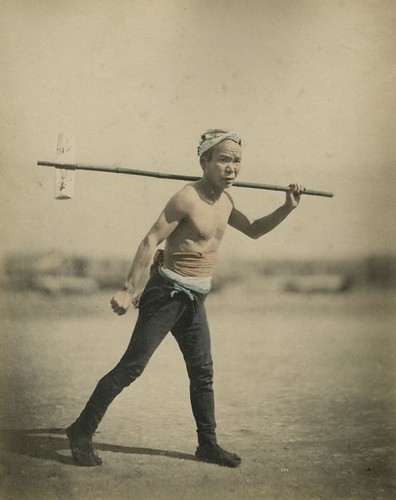Tuesday, May 07, 2013
Flying Legs Japanese Postmen
These postmen were called "hikyaku" (飛脚 or literally "flying legs") in Japanese.
It is said that they ran the Tokyo Osaka route in 6 days or 90km a day, and in 4 and a half days when carrying especially urgent mail. That is 120Km a day.
It is also said that they ran in a special way to conserve energy but the wikipedia site says that it is not clear what this special way is though it is rumoured to be the "Nanba Running/Walking" form in which runners and walkers swing their right hand forward at the same time as their right leg, and vice versa, rather than in time with the opposite leg. There appears to be photographic proof of this theory here. And indeed the position of the postman pictured above is consistent with this theory.
There is a saying in Japanese "Satsuma's Postman," which refers to the Satsuma (current day Kumamoto prefecture) region of Japan and postmen that arrived there were proverbially at least killed, or not allowed to return to whence they came, since the region was planning a revolution (with the Choushu region, current day Yamaguchi Prefecture) and did not wish its secret preparations to become known. So a "Satsuma's Postman" means someone who does not return.
A famous Japanese courier company has a "Hikyaku" postal service which uses its trucks combined with the Japanese postal service' post workers. The company sorts and transports, the postal workers deliver, and they claim faster times than leaving the whole delivery to the postal workers.
I wonder the reason for the pole. At times the pole seems to have served as a kind of rucksack for allowing heavy items to be carried using the muscles in the back, similar to the way in which the English migrant "Dick Wittington" is often portrayed carrying his possessions in a cloth hung from a pole over his shoulder.
This does not explain why these Japanese postmen would carry light items such as that shown in this photo in the same way. The only mention I can see of the pole on the Japanese wikipedia page is the tradition of "Town postmen" to trail a small bell from their pole" so that people would hear them coming (and presumably deposit letters with them). But this man has no bell. Could the pole also have been a letter passer, to allow letters to be received and delivered at a distance, and thus a precursor of the ubiquitous Japanese mask, to prevent the transmission of infectious disease (which was rife in Edo period Japanese cities)?
It is said that they ran the Tokyo Osaka route in 6 days or 90km a day, and in 4 and a half days when carrying especially urgent mail. That is 120Km a day.
It is also said that they ran in a special way to conserve energy but the wikipedia site says that it is not clear what this special way is though it is rumoured to be the "Nanba Running/Walking" form in which runners and walkers swing their right hand forward at the same time as their right leg, and vice versa, rather than in time with the opposite leg. There appears to be photographic proof of this theory here. And indeed the position of the postman pictured above is consistent with this theory.
There is a saying in Japanese "Satsuma's Postman," which refers to the Satsuma (current day Kumamoto prefecture) region of Japan and postmen that arrived there were proverbially at least killed, or not allowed to return to whence they came, since the region was planning a revolution (with the Choushu region, current day Yamaguchi Prefecture) and did not wish its secret preparations to become known. So a "Satsuma's Postman" means someone who does not return.
A famous Japanese courier company has a "Hikyaku" postal service which uses its trucks combined with the Japanese postal service' post workers. The company sorts and transports, the postal workers deliver, and they claim faster times than leaving the whole delivery to the postal workers.
I wonder the reason for the pole. At times the pole seems to have served as a kind of rucksack for allowing heavy items to be carried using the muscles in the back, similar to the way in which the English migrant "Dick Wittington" is often portrayed carrying his possessions in a cloth hung from a pole over his shoulder.
This does not explain why these Japanese postmen would carry light items such as that shown in this photo in the same way. The only mention I can see of the pole on the Japanese wikipedia page is the tradition of "Town postmen" to trail a small bell from their pole" so that people would hear them coming (and presumably deposit letters with them). But this man has no bell. Could the pole also have been a letter passer, to allow letters to be received and delivered at a distance, and thus a precursor of the ubiquitous Japanese mask, to prevent the transmission of infectious disease (which was rife in Edo period Japanese cities)?
Labels: japan, japanese culture, 日本文化
This blog represents the opinions of the author, Timothy Takemoto, and not the opinions of his employer.

